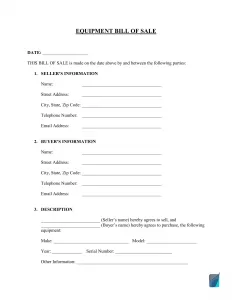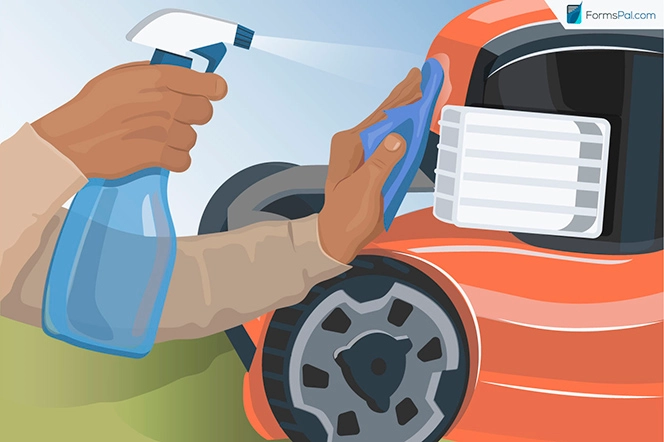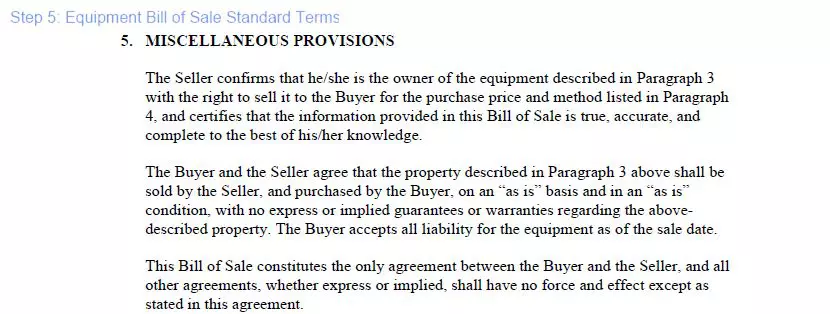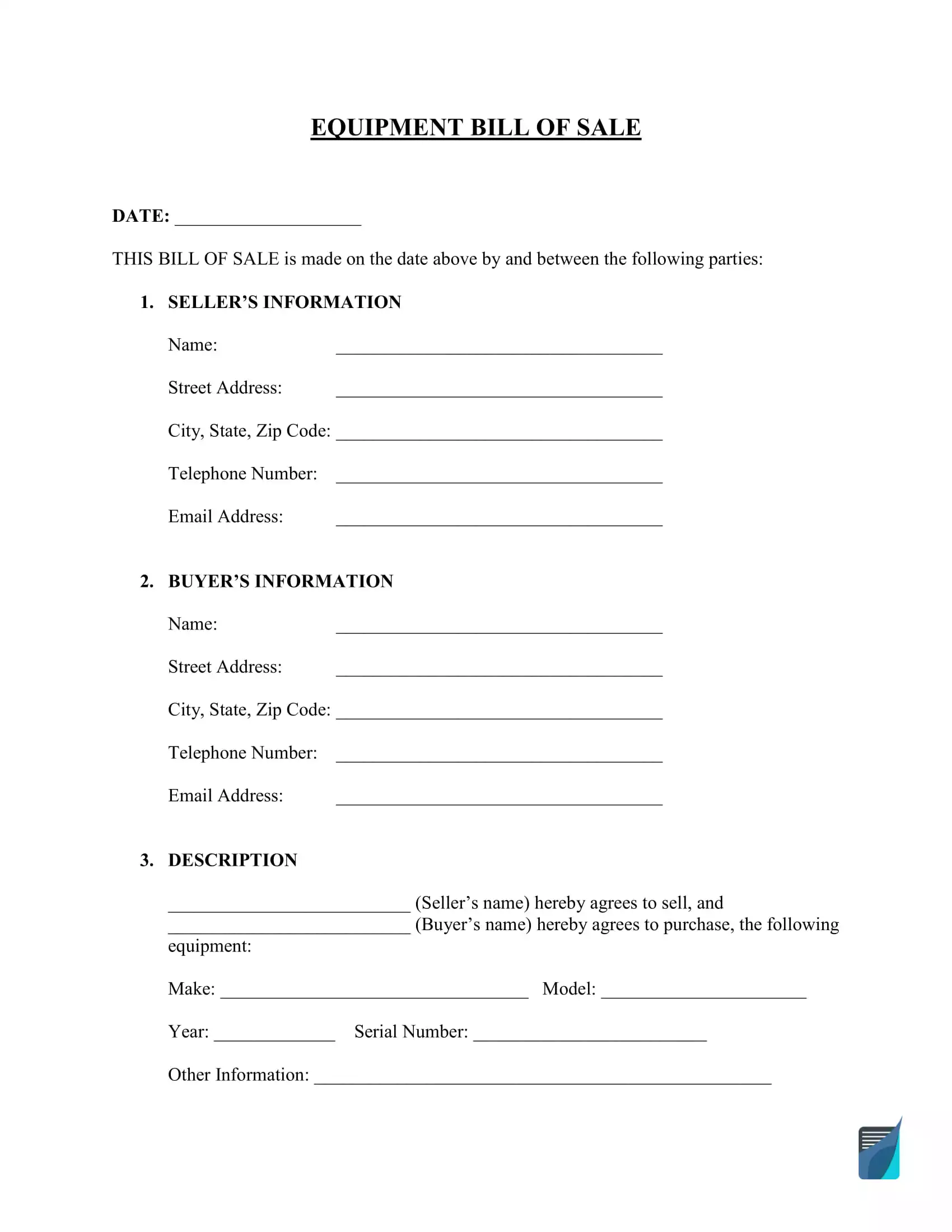Equipment Bill of Sale Form
A bill of sale for equipment is a document that certifies the transition of ownership rights from a seller to a buyer for any machinery, electronics, or heavy equipment. Crucial details included are the object of sale, its purchase price, type, and payment method, along with comprehensive information about both the buyer and the seller.
The scope of an equipment bill of sale encompasses a wide variety of machinery and equipment, ranging from everyday items like a lawn mower or computer to more specialized heavy equipment and farm machinery (skid steer, forklift, etc.). Any appliances powered by gas, fuel, or electricity are also included under its umbrella.
Why Use an Equipment Bill of Sale?
A bill of sale lends credibility and legal validity to the transfer of ownership, encapsulating all pertinent details about the purchased item, such as its production year, serial number, and condition. This document essentially functions as a legally binding contract that outlines the purchase price and the mutually agreed-upon obligations of the parties involved. Consequently, it fosters a sense of security for both the seller and the buyer, ensuring their rights are well-protected in the transaction.
Equipment Bill of Sale Form Details
| Document Name | Equipment Bill of Sale Form |
| Other Names | Farm Equipment Bill of Sale, Machinery Bill of Sale |
| Avg. Time to Fill Out | 10 minutes |
| # of Fillable Fields | 56 |
| Available Formats | Adobe PDF; Microsoft Word |
| Often used in | Texas, Georgia, Oregon, Florida, and Alabama |
| Often used for | Kitchen equipment, complex machinery, musical instruments, outdoor equipment, staging equipment, storage solutions, fax machines, agriculture machinery, and power and office tools. |
Can I Create an Equipment Bill of Sale Online?
Creating a bill of sale from scratch may appear daunting to some, given the legal complexities involved. However, a well-crafted document, complete with all relevant details and conditions, acts as a bulwark against potential legal disputes and misunderstandings.
Our website hosts a myriad of bill of sale forms designed to accommodate a wide range of commercial transactions, including equipment sales. These forms are available in both .docx (Microsoft Word) and .pdf formats for your convenience. Download the form that fits your needs, fill in the requisite information, and add your signature to validate the transaction legally.
In addition to our pre-formatted downloadable forms, we also provide an online form builder, allowing you to customize your document further.

How Do I Sell Equipment?
Selling equipment can be a straightforward process, as there’s generally a demand for various types of equipment. The key to a successful transaction is finding a reliable buyer, which can be achieved by following a systematic process.
Step 1. Prepare the Equipment

Most equipment experiences some wear and tear through usage. Your first task is to clean and prepare your item for sale. Buyers are more inclined towards equipment that appears well-maintained or near-new.
Step 2. Advertise Your Sale Widely

Once your equipment is ready for sale, take clear, high-quality photographs and advertise on as many platforms as possible. Ensure you include all relevant information about the item and your contact details. Platforms like EquipmentTrader are ideal for showcasing your equipment.
Step 3. Engage in Negotiations with Potential Buyers

Buyers often aim to negotiate the price down, so be prepared for this. Having a clear idea of your bottom line price is crucial, but also consider having a little wiggle room to make the deal more attractive to prospective buyers.
Step 4. Complete the Bill of Sale

A transaction is legally recognized once the bill of sale form is filled out and signed. Both the buyer and seller should retain a copy of this legal document to safeguard their interests. The bill of sale for your equipment should include the following details:
- Date of the sale
- Buyer’s personal details (name, address)
- Seller’s personal details (name, address)
- Equipment’s purchase price
- Equipment’s serial number and model
- Seller’s signature (the buyer’s signature is typically optional)
How to Write an Equipment Bill of Sale?
The instructions provided here are based on the equipment bill of sale template provided by us.
Step 1: Document Date
Begin by noting down the date of the document’s creation.

Step 2: Buyer’s and Seller’s Details
Enter the buyer’s and seller’s particulars, including:
- Name
- Address: Street, City, State, Zip code
- Contact details: Phone number, Email address

Step 3: Equipment Description
- Equipment Manufacturer
- Equipment Model
- Year
- Serial Number
- Any other relevant details

Step 4: Transaction Details
Indicate the date of the sale and the total price to be paid for the equipment. Next, specify the method of transaction:
- Single payment: The buyer pays the entire sum in one go, and the equipment is delivered immediately.
- Installments: Indicate the dates and amounts of the first and final payments.
Next, choose a payment method:
- Cash
- Check
- Cashier’s cheque
- Money order
Also, specify if all applicable taxes are included in the purchase price.

Step 5: Terms and Conditions
Review the standard terms, ensuring both parties understand them. Typically, these terms affirm the seller’s ownership and legal right to sell the equipment and confirm that the bill of sale’s details are accurate. The buyer acknowledges the equipment is sold in an “as-is” condition and accepts responsibility upon completion of the sale.

Step 6: Signatures
While the buyer’s signature is usually optional, it’s recommended to have both parties sign the document for added security. Having one or two witnesses present during signing can also be beneficial.

Step 7: Notarization (Optional)
Notarizing the bill of sale offers additional legal protection. However, this step is typically optional and dependent on your jurisdiction’s requirements.


